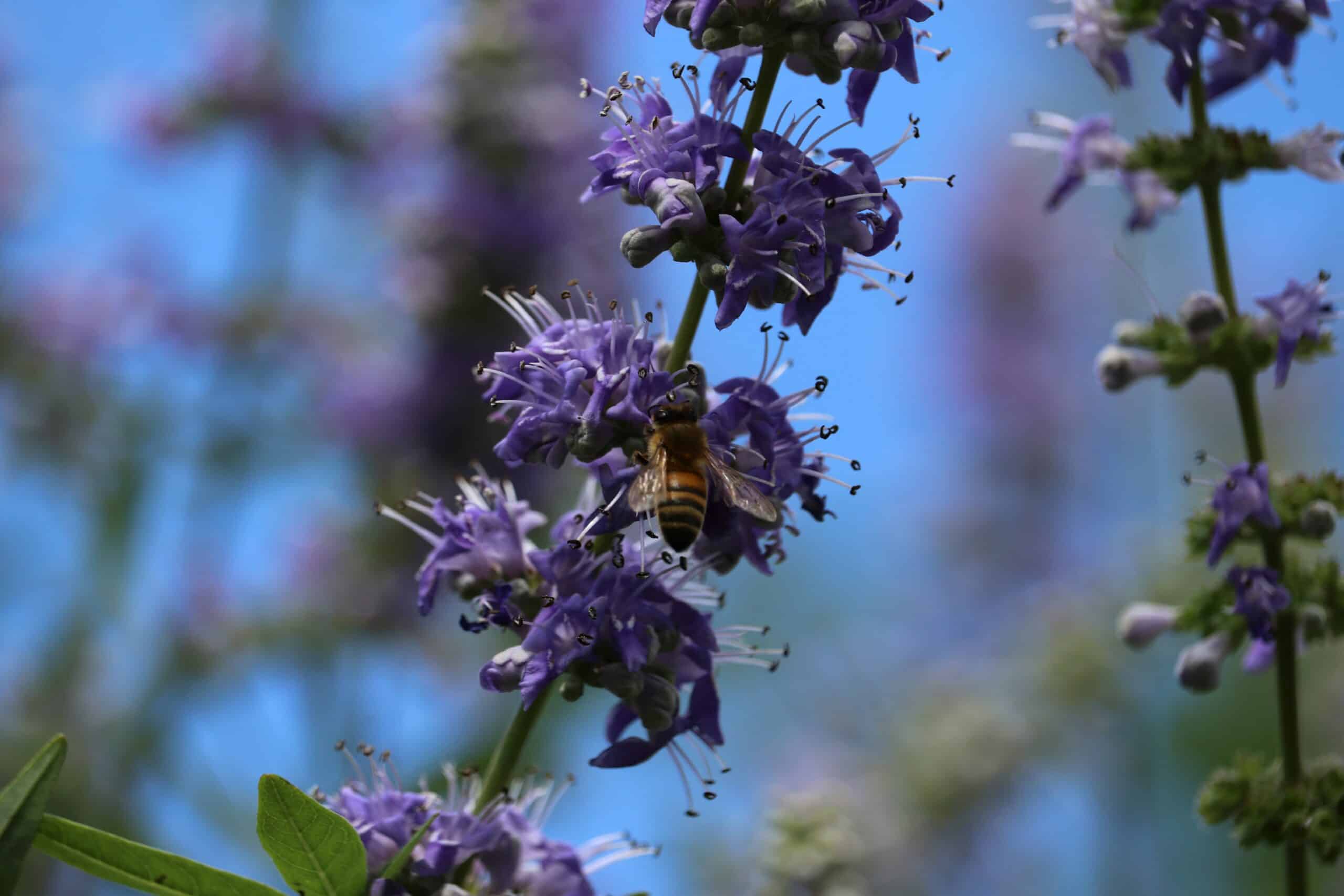The Chaste Tree (Vitex) is an attractive and versatile shrub that has been used in garden landscaping for many centuries. Its beautiful flowers, glossy leaves, and easy care make it one of the most popular plants for gardeners of all levels of expertise. This guide will explain how to grow and care for the Chaste Tree, so you can enjoy its beauty in your own backyard.
As a specialist in botany and gardening, I have had great success with growing the Chaste Tree in my garden. The plant is easy to propagate from cuttings or seeds, making it ideal for novice gardeners who are just starting out. Once established, the plant requires minimal upkeep and can thrive with only occasional watering and pruning when needed.
The Chaste Tree also offers numerous benefits beyond its decorative value. Its leaves can be harvested to make tea or tinctures which may help alleviate symptoms of menopause, premenstrual syndrome (PMS), hormonal imbalances, and other health conditions. The plant is also known to attract beneficial insects like butterflies, bees, and hummingbirds to your garden – making it an ideal choice for those who wish to serve their community by creating a habitat for these pollinators.
Identifying Chaste Tree
Identifying a chaste tree can be tricky, as they come in many shapes and sizes. There are two main types of Vitex, deciduous and evergreen, that can range from small shrubs to medium-sized trees. Though it’s easy to spot the white flowers that bloom each summer, the leaves and bark may vary depending on the cultivar chosen for planting. While some may have a unique five-lobed shape, others may feature serrated edges or even heart-shaped foliage.
When it comes to caring for your chaste tree, there are few tips and tricks to keep in mind. In terms of soil requirements, this type of tree prefers well-drained, slightly acidic soils with plenty of compost or mulch added to help retain moisture during dry spells. It also benefits from regular fertilization throughout the growing season with a slow release fertilizer or liquid feeder.
Finally, it is important to remember that chaste trees require ample sunlight throughout their life cycle in order to thrive and produce their beautiful blooms year after year. Aim for at least 6 hours per day as they don’t take kindly to shade or overwatering; be sure not to give them too much water as this could damage their roots and cause them stress! With these simple steps you will be able to ensure your chaste tree is healthy and happy for years to come.
Where To Plant A Chaste Tree
When deciding where to plant your chaste tree, it’s important that you take into account its sun and soil requirements. Depending on the variety, Vitex agnus-castus can tolerate full sun or part shade. Generally, they should be planted in an area that gets at least six hours of sunlight per day. It’s also important to evaluate the soil before planting; chaste trees prefer well-draining soils with a neutral pH level. If your soil is too alkaline or acidic, you can amend it with compost or peat moss to bring it closer to a neutral pH level.
When selecting a spot for your chaste tree, keep in mind that it will reach heights of 10-15 feet and 5-10 feet wide at maturity. Be sure that there is enough space for the plant to grow and spread out without interfering with other nearby plants or structures. Additionally, try to avoid areas where water pools after a heavy rain as this could lead to root rot in the plant over time.
No matter what type of soil you have in your garden, adding organic material such as compost before planting will set up your chaste tree for success and ensure that it has proper drainage and ample nutrients. With this information in mind, you should have no trouble finding the perfect location for your chaste tree!
Sun And Soil Requirements For Chaste Tree
Growing a chaste tree (Vitex) in the garden is a great way to add both beauty and fragrance. Take the example of a family in California, who have successfully grown one for many years now. With proper sun and soil requirements for chaste tree, growing this shrub can be very rewarding.
When it comes to chaste trees, there are particular conditions that need to be met for them to thrive. They need full sun exposure throughout most of the day. Placing the shrub in partial shade will limit its growth and could lead to it producing fewer blooms than expected. In terms of soil, they prefer well-draining soil with a slightly acidic pH level ranging from 6.0-7.0. If you’re unsure about your soil’s pH levels or drainage capabilities, consider having it tested or amended as needed before planting your chaste tree.
Additionally, if you’re planting more than one chaste tree, make sure to space them at least eight feet apart so that each bush gets adequate sunlight and room to grow without crowding each other out. Providing them with good quality soil and proper spacing will help ensure that these beautiful shrubs reach their fullest potential in your garden!
Water Requirements For Chaste Tree
Watering a chaste tree is the most important step in ensuring its health. Like any other plant, it needs enough water to reach its full potential. But don’t go overboard – too much of a good thing can be detrimental to your chaste tree. It’s a delicate balance that requires patience and attentiveness to master.
The key is understanding when and how much to water your chaste tree. Make sure that your soil is evenly moist but not soggy – this will ensure the roots are getting enough water without being overwhelmed with the amount of moisture. If you’re unsure of how often you should be watering, try sticking your finger about two inches into the soil – if it feels dry, then it’s time for another drink!
If you live in an area where there’s plenty of rain, you won’t need to worry too much about watering your chaste tree – Mother Nature has got that covered. However, if rainfall isn’t plentiful, then you may need to supplement with periodic deep soakings every few weeks or so – just make sure to avoid overwatering and let the soil dry out between sessions. TIP: During especially hot weather, make sure to give your chaste tree extra attention with more frequent (but shallow) waterings and possibly some mulch around the base of the tree for added insulation and moisture retention.
Fertilizing A Chaste Tree
Fertilizing a chaste tree is an important part of its care and maintenance. Chaste trees require a balanced fertilizer with a 10-10-10 or 8-8-8 NPK ratio, which can be applied in early spring as soon as the soil has thawed. The amount of fertilizer will depend on the size of your plant, but generally, a handful spread over the root zone should suffice. It’s also important to keep the fertilizer away from the trunk of the tree, as this could cause damage.
To encourage healthy growth, you may also consider foliar feeding – that is, spraying liquid fertilizer directly onto the leaves. This will provide additional nutrients to the foliage and help promote lush growth and vibrant flowers during bloom season. It’s best to do this every couple of weeks while actively growing and flowering; just be sure not to do it too often or you could burn or damage your plant!
When fertilizing your chaste tree, remember that less is more—overfertilization can lead to too much nitrogen in your soil which can slow down flower production. When used properly and sparingly, however, fertilizing your chaste tree can be an effective way to give it an extra boost and ensure it stays healthy throughout its growing season.
With proper fertilization in place, we’re now ready to move on to pruning our chaste tree for optimum shape and health.
Pruning Chaste Tree
Pruning chaste tree is like sculpting a masterpiece: it requires careful attention and an understanding of the plant’s needs in order to create its desired shape. As a specialist in botany and gardening, I recommend some key points for pruning chaste tree that will help you get the most out of your shrub or small tree.
Firstly, it’s important to understand when to prune your chaste tree. In general, avoid pruning during the peak growing season – late spring or early summer – as this can lead to reduced blooming and even death of the plant. The best time for pruning is in late autumn or early winter when the plant is dormant. Secondly, make sure you use clean tools when pruning as this helps reduce disease transmission. Finally, be selective about what branches you prune off; remove any dead, diseased or damaged branches first, then thin out overly dense areas by cutting back the longest stems that are crossing over each other.
Ultimately, pruning correctly will help maintain an attractive shape while allowing enough foliage to produce flowers and fruit. And with these tips in mind, you’ll be able to keep your chaste tree looking neat and healthy for years to come! To top off your efforts, don’t forget to control pests and diseases which can further improve your chaste tree’s health and growth.
Controlling Pests And Diseases For Chaste Tree
Controlling pests and diseases is an important part of caring for chaste tree (Vitex). However, it is typically quite resistant to pests and diseases. Nonetheless, it’s important to be aware of the potential problems that can arise.
Generally, most insects won’t bother chaste tree because of its strong odor. That said, spider mites and aphids may still find their way onto the plant. To treat these plants, you can use a combination of insecticidal soap and horticultural oil. These methods should be used according to label instructions and applied when temperatures are below 85°F (29°C).
Furthermore, occasionally a chaste tree may get powdery mildew or stem cankers. If this occurs, you’ll need to prune off any infected parts of the plant and dispose of them properly. You can also use fungicides, such as neem oil or sulfur-based products, if necessary. As always with fungicides, follow the directions on the label carefully for best results.
Proper pest control is an essential part of caring for your chaste tree in order to keep it healthy and looking its best. To ensure that your plant stays in top condition, it’s important to monitor it regularly throughout the season for potential issues that might arise.
When To Harvest Chaste Tree
Have you ever thought about when to harvest your chaste tree? Harvesting the fruits of this plant is key to ensuring its growth and health. As a specialist in botany and gardening, I can tell you that there are a few things to keep in mind when it comes to harvesting chaste tree.
First of all, it’s important to have a good understanding of when the fruit is ripe enough to pick. The best time to harvest chaste tree fruit is when they turn from green to purple-black in color. This usually happens around late summer or early fall. If you wait too long after that point, the fruits will be overripe and may not taste as good.
It’s also important to know how much fruit you should pick at one time. Too little means that the plant won’t get the nutrients it needs for proper growth, while too much can lead to fewer flowers on next year’s crop. Aim for an average of 10-15 fruits per branch and make sure that each branch still has some unripe fruit left so that the plant can regenerate for next year’s season.
Finally, once you’ve harvested your crop, be sure not to leave any fallen leaves or branches behind on your plants as these can attract pests and diseases which could damage your chaste tree further down the line. Taking care of the plant before harvesting will help ensure a healthy crop every year!
Uses For Chaste Tree
Chaste trees (Vitex agnus-castus) are a hardy and attractive addition to the garden, with many uses and benefits. As a deciduous tree or shrub, they can provide year-round interest with their fragrant flowers in summer and attractive bark in winter. In addition to being an ornamental plant, chaste tree has several practical uses.
The most common use of chaste tree is as an herbal supplement. The fruit of the tree, called chasteberries, have been used for centuries to treat female hormones issues such as PMS and menopause symptoms. Chasteberry extract is readily available in health food stores and online, although it’s important to be aware of potential side effects before taking any herbal medicines.
In addition to its medicinal properties, Vitex agnus-castus can also be used in cooking and crafts. The fruits can be dried or cooked into jams or jellies. The leaves can be brewed into tea or added to salads for a unique flavor. Finally, the wood from chaste trees makes excellent firewood or can be carved into decorative items like figures or jewelry boxes.
Given its many uses, it’s no surprise that chaste tree is becoming increasingly popular among gardeners looking for an attractive plant with practical applications. Whether you’re looking for a beautiful flowering shrub or an herbal remedy, this versatile plant is sure to fit the bill! With proper care and maintenance, it will bring beauty and utility to your outdoor space for years to come.
Propagating Chaste Tree
Through propagation, chaste tree can be grown and cared for in any garden. It’s an exciting process that can help you reap the many benefits of this beautiful plant. To start, let’s take a look at how to propagate chaste trees with ease. Astonishingly, propagating chaste trees is easy to do!
First, you will want to prepare a good quality potting mix. Chaste trees love well drained soil that is rich in organic matter and slightly acidic. Next, take some cuttings from healthy branches of your existing plants and dip them in rooting hormone to stimulate root growth. Finally, place the cuttings into prepared pots or containers filled with potting soil and water them thoroughly.
Once planted, place the potted plants in a warm area that receives bright indirect sunlight and keep the soil moist but not wet. After about four weeks of proper watering and light exposure, your cuttings should begin developing roots. Once established on their own and showing signs of new growth, you can transplant them into larger pots or directly into your garden beds!
With the right preparation and care, you can have an abundance of these beautiful plants growing in no time! Now that we’ve covered how to propagate chaste tree easily at home let’s move onto exploring the common varieties available.
Common Varieties Of Chaste Tree
Chaste tree (Vitex) is a hardy, easy-to-care-for shrub that comes in many varieties. With its fragrant flowers and attractive foliage, it’s no surprise that these plants are becoming increasingly popular among gardeners. In this section, we will discuss the most common varieties of chaste tree available for home gardeners to enjoy.
The first type of chaste tree is the Texas Lilac (Vitex agnus-castus). This variety grows up to ten feet tall and has a dense, bushy growth habit. Its sweetly scented purple blooms appear in mid-summer and attract butterflies and bees alike. The second type is Vitex negundo, also known as the Chinese Chastetree or Hemp Tree. This shrub can grow up to twenty feet tall and has deep green leaves with white flowers that bloom in late summer. The third variety is Vitex trifolia, also known as Threeleaf Chastetree or Chasteberry Tree. This shrub has light pink flowers with three leaflets on each leaf and can reach heights of up to fifteen feet tall. Finally, Vitex rotundifolia, also known as Beach Vitex or Roundleaf Chastetree, is a low-growing shrub with reddish purple flowers that bloom from early summer until fall.
No matter which variety you choose for your garden, it’s important to provide them with plenty of sun and well-draining soil for optimal growth and flowering potential. With proper care and attention, these beautiful plants can be enjoyed year after year by home gardeners everywhere! Now let’s move on to the next step: understanding common problems with chaste tree plants so we can keep them healthy and happy!
Common Problems With Chaste Tree
Do chaste trees often have problems? Unfortunately, there are some common issues associated with growing this plant. Let’s explore the common problems of chaste tree and how to deal with them:
• Pests such as aphids and whiteflies can infest chaste trees. To get rid of them, regular applications of insecticidal soap can help.
• Powdery mildew can also be a problem for chaste trees. To prevent it, make sure your plant is getting adequate air circulation and morning sun.
• Chaste trees are susceptible to root rot if they’re over-watered or planted in poorly draining soil. To avoid this, water your plants only when the soil is dry to the touch and use well-draining soil when planting or repotting.
• Too much fertilizer can cause damage to the foliage of chaste trees. When fertilizing, always follow the instructions on the package carefully; too much fertilizer can burn the roots and leaves of your plants.
• Chaste trees may suffer from poor growth in cold climates or if exposed to frost during winter months. If this happens, it’s best to move your plants indoors until temperatures rise again.
These are just a few of the potential problems that gardeners need to be aware of when growing chaste tree (Vitex). However, by following proper planting and care guidelines, you should be able to successfully grow these beautiful plants and reap their many rewards! With proper maintenance and attention, these lovely shrubs will provide long-term enjoyment for any gardener or landscaper.
Benefits Of Growing Chaste Tree
Chaste tree (Vitex) is an attractive, hardy plant that has many benefits for gardeners. It is an excellent choice for a low-maintenance border or hedge, as it needs minimal pruning and care. Chaste tree can also be grown in containers both indoors and outdoors, offering year-round color and texture. Its fragrant blooms attract beneficial pollinators such as bees, butterflies, and hummingbirds to your garden. The foliage provides a pleasant scent when crushed and the berries are edible for birds.
Growing chaste tree also offers many other benefits. It is highly drought-tolerant once established, making it ideal for sunny spots with low water requirements. This evergreen shrub grows quickly, adding height and structure to a landscape in just a few years. As it prefers alkaline soil conditions, it can be a great choice if you’re looking to fill in areas with poor soil quality.
Overall, chaste tree is an easy-to-care-for shrub that provides year round interest in the garden while requiring minimal effort from the gardener. With its colorful blooms and pleasant fragrance, this lovely shrub adds beauty to any landscape while providing valuable resources for wildlife in your yard. As we move on to consider alternatives to chaste tree, let’s take a look at some other plants that offer similar benefits but may work better in specific areas or climates.
Alternatives To Chaste Tree
If you are looking for an alternative to the chaste tree, there are a few options available. Many gardeners opt for Buddleja davidii, commonly known as butterfly bush. This deciduous shrub produces fragrant flowers that attract bees and butterflies, so it is perfect for those who want a colorful addition to their garden. There are also a number of herbs that can be used in place of the chaste tree, such as rosemary and oregano. These herbs can provide both culinary and medicinal benefits while adding a unique flavor to any dish.
For those who prefer trees over bushes or herbs, there are several other alternatives available. The Russian olive tree (Elaeagnus angustifolia) is popular in many gardens due to its hardiness and ability to tolerate a variety of soils. This tree produces small yellow flowers during the summer months and silvery-white berries in the autumn that can be used for making jams or jellies. Additionally, there is the evergreen olive tree which has long been associated with Mediterranean climates and provides year-round greenery.
Whichever type of plant you choose, it is important to research its needs before planting it in your garden so that you can ensure your plants thrive throughout the growing season. With proper care and maintenance, these alternatives can offer an excellent substitute for growing chaste tree if it isn’t suitable for your area or desired landscape design. Understanding how each plant responds to its environment will help you determine which option best suits your needs and preferences.
Tips For Growing Chaste Tree
Eager to bring a touch of the Mediterranean to your garden? Then Vitex, or Chaste Tree, is an ideal choice. With a little help from you and some patience, this lovely deciduous shrub can be a perfect addition to your outdoor space. Let’s explore what it takes to grow and care for this special tree.
When it comes to growing Chaste Trees, there are several tips that can help ensure your success. Firstly, make sure it receives plenty of sunlight – six hours or more per day is best. You’ll also want to pay attention to its soil needs; Chaste Trees like well-draining soil that’s rich in organic matter. Watering regularly will also encourage healthy growth – be sure not to overdo it though!
Finally, although they’re generally quite hardy plants, Chaste Trees still require occasional maintenance and pruning in order to keep them looking their best. Prune back any dead branches or shoots that may occur after heavy winter weather and remove any suckers that appear beneath the main trunk. In addition, fertilizing every spring with a balanced fertilizer can give your tree a boost and help promote lush foliage growth.
With proper care and maintenance, you can enjoy many years of beauty from your Chaste Tree!
Frequently Asked Questions
How Long Does It Take For A Chaste Tree To Reach Maturity?
When gardening, it always pays to look ahead. Planting with the future in mind is essential for success. Such is the case for the Chaste Tree, or Vitex. While its mature form is striking and desirable, it takes time to achieve that beauty. How long?
In general, a Chaste Tree will take three to five years before it reaches its full size. It should be grown in full sun and planted in the early springtime. Its natural shape is upright and reaching so it should be given enough room to grow without being crowded out by other plants. During its growth period, it can reach a mature height of 12 feet or more with an equal spread of branches and foliage. It also has lovely lavender flower clusters that bloom throughout the summer months until frost arrives in fall.
To maintain this perfect specimen of a tree, regular pruning is needed to keep its shape and size under control as well as fertilization during the growing season for optimal health and growth. Additionally, watering during dry spells will help ensure healthy foliage year-round and prevent root rot from setting in due to overly wet conditions. With these simple steps taken on a regular basis, your Chaste Tree will remain strong and majestic for many years to come!
What Is The Best Time Of Year To Plant A Chaste Tree?
Planting a chaste tree at the right time of year is key to ensuring its success in your garden. It’s best to plant chaste trees in early spring when the chances of frost have passed and the ground has had time to warm up. This will give the tree a head start, as it can take advantage of warmer weather and longer days that encourage growth and development.
When planting your chaste tree, make sure to select a spot that gets full sun exposure, as this tree thrives in sunny locations. Prepare the soil by digging a hole twice as wide as the root ball and mixing in some compost or other organic matter. Be sure to water well after planting, then mulch around the base of the tree with 2-3 inches of organic material such as shredded bark or straw.
Chaste trees are hardy plants that require little maintenance once established, but keep an eye out for pests and diseases. To ensure healthy growth, be sure to water during dry spells – especially during their first season in your garden – and prune regularly to maintain desired shape and size. With proper care and attention, your chaste tree will reward you with beautiful blooms each summer!
How Often Should A Chaste Tree Be Watered?
The Chaste Tree, also known as Vitex, is a symbol of virtue and chastity. Its fragrant purple flowers are a sight to behold, and its benefits do not stop there. This tree requires special care to ensure it grows strong and healthy. One of the most important aspects of caring for this tree is watering it properly.
Watering the Chaste Tree should be done regularly and consistently throughout the year. It needs an inch or two of water each week during the growing season (spring through early fall). During hot summer months, you may need to increase that amount – especially if your soil is clayey or sandy. Also, make sure that you water deeply enough to reach the root zone – at least 6-8 inches deep. Mulching around the base of the tree can help keep moisture in the soil and reduce evaporation from direct sunlight.
In addition to regular watering, fertilizing your Chaste Tree can help give it an extra boost of nutrition. A slow-release fertilizer applied once a year in spring is ideal for this tree; however, it should be noted that over-fertilizing can cause excessive growth which will lead to more pruning later on down the line. Pruning should generally be done after flowering has finished in late summer or early fall; this will keep your tree looking neat and tidy with minimal effort!
By following these tips for proper watering and fertilizing, you’ll be able to keep your Chaste Tree healthy and vibrant all year long! With proper care and attention, this beautiful tree will bring joy for many years to come.
What Are The Best Fertilizers To Use For A Chaste Tree?
Nurturing a chaste tree (Vitex) requires the right fertilizer for optimal growth and health. Feeding your chaste tree with the correct nutrients is essential for achieving lush, vibrant foliage and long-lasting blooms. As a specialist in botany and gardening, I’m here to help you discover the best fertilizers to use for your chaste tree.
Fertilizing your chaste tree will ensure it maintains its healthy state during its growing season. A balanced, slow-release fertilizer is an ideal choice as it will provide nutrition over a longer period of time rather than one single application. You can also apply organic matter such as compost or manure around the base of the plant in order to encourage further growth and health.
When applying fertilizer to your chaste tree, make sure not to overdo it as this can lead to leaf burn or even death of the plant. Apply according to package instructions correctly and be sure to water afterwards so that the fertilizer can be absorbed into the soil properly. With proper care and attention, your chaste tree will reward you with lush greenery and beautiful blooms year after year.
Fertilizing your chaste tree is key to having a healthy plant that will thrive in any environment. By using the right type of fertilizer and applying it correctly, you can enjoy beautiful foliage and abundant blooms without worrying about leaf burn or damage caused by improper fertilization. With some TLC, you’ll have a stunningly vibrant chaste tree in no time!
What Are The Best Ways To Control Pests And Diseases On A Chaste Tree?
Chaste tree (Vitex) is an absolute blessing to have in any garden! With its vibrant purple-blue flowers, it’s a sight to behold. However, if you want your chaste tree to stay healthy and strong, you must take steps to control pests and diseases. Fortunately, with the right knowledge and effort, this can be done easily!
First off, it’s important to understand that prevention is key in avoiding pests and diseases. Regularly inspect your chaste tree for signs of infestation or disease. If you spot any issues early on, you can act quickly to prevent them from getting worse. Here are some tips for preventing pest and disease problems: •tKeep the area around your plant free of debris •tWater your plant at ground level rather than overhead •tRegularly check your plant for signs of infestation or disease •tUse organic mulch around the base of the plant
If you do spot a pest or disease problem on your chaste tree, there are several different treatments available depending on what the issue is. For instance: •tChemical Treatments: These include insecticides for pest control and fungicides for disease control. Make sure to read the label carefully before applying any chemical treatments as they can be hazardous if not used correctly. •tOrganic Treatments: Natural alternatives such as neem oil or garlic spray can be used to keep pests away from your plant. You may also consider introducing beneficial insects such as ladybugs or lacewings into your garden which will help keep pests under control naturally. •tCultural Practices: Proper cultural practices such as pruning dead branches or removing infected foliage can help reduce disease pressure on your chaste tree and keep it healthy overall.
It takes dedication and patience to keep pests and diseases away from a chaste tree but with the right approach and regular maintenance, it can be done successfully! Armed with these preventative measures and treatment methods, you’ll be able to enjoy beautiful blooms all season long without worry!
Conclusion
The Chaste Tree (Vitex) is a beautiful and low-maintenance addition to any garden. With proper care and maintenance, this tree can add beauty and interest to a landscape for many years to come. As an ancient symbol of chastity, it is also a great reminder of the importance of taking care of our environment for future generations.
To ensure that your Chaste Tree reaches its full potential, it is important to consider the best time for planting, how often to water, and what type of fertilizer and pest control measures are best suited for your specific tree. By following these steps, you will be able to nurture your Chaste Tree as if it were an old friend—with gentle guidance, patience, and lots of love.
With the right amount of effort and attention, you can enjoy the fruits of your labour in the form of a lush Chaste Tree that stands proudly in its spot like an old sentinel watching over its domain. The symbolism behind this tree is clear—love nature and nurture her with care so that she may always remain strong and vibrant in her beauty.





























